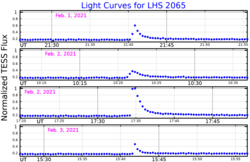LHS 2065
| Observation data Epoch J2000 Equinox J2000 | |
|---|---|
| Constellation | Hydra[note 1] |
| Right ascension | 08h 53m 36.16047s[2] |
| Declination | −03° 29′ 32.1975″[2] |
| Apparent magnitude (V) | +18.959[3] |
| Characteristics | |
| Evolutionary stage | Ultracool dwarf[4][5] |
| Spectral type | M9V[4] |
| Variable type | Flare star[5] |
| Astrometry | |
| Radial velocity (Rv) | 7±2[3] km/s |
| Proper motion (μ) | RA: −516.605 mas/yr[2] Dec.: −199.652 mas/yr[2] |
| Parallax (π) | 115.4876 ± 0.0726 mas[2] |
| Distance | 28.24 ± 0.02 ly (8.659 ± 0.005 pc) |
| Details | |
| Mass | 0.082±0.002[6] M☉ |
| Radius | 0.113±0.006[6] R☉ |
| Luminosity | 3.39+0.16 −0.15×10−4[7] L☉ |
| Surface gravity (log g) | ~5.5[7] cgs |
| Temperature | 2,317+61 −56[6] K |
| Age | >0.5[5] Gyr |
| Other designations | |
| Database references | |
| SIMBAD | data |
LHS 2065 is a red dwarf star, one of the smallest stars ever found with around 8.2% the mass of the Sun and a diameter only 10% greater than Jupiter.[6] It is one of the few ultracool dwarfs known to have flare activity, emmiting one flare every 33 hours,[5] and is also an active X-ray emitter.[4]
Parallax measurements by the Gaia spacecraft give a distance of 8.66 parsecs (28.2 ly) to LHS 2065.[2] This star was first recorded by the Luyten Half-Second catalogue, a catalogue of stars with proper motions exceding 0.5". The star's main identifier is named after this catalogue.[8] It is located in the Hydra constellation.[note 1]
This star has a spectral type of M9V,[4] indicating a very cool star at the end of the main sequence. It is among the nearest ultracool dwarfs to Earth.[5] LHS 2065 has an effective temperature of around 2,317 K,[6] 2.5 times less than the Sun. The lack of lithium in the star's atmosphere indicate that it must be over 500 million years old.[5]
See also
[edit]Notes
[edit]References
[edit]- ^ "MAST: Barbara A. Mikulski Archive for Space Telescopes". Space Telescope Science Institute. Retrieved 23 September 2024.
- ^ a b c d e f Vallenari, A.; et al. (Gaia collaboration) (2023). "Gaia Data Release 3. Summary of the content and survey properties". Astronomy and Astrophysics. 674: A1. arXiv:2208.00211. Bibcode:2023A&A...674A...1G. doi:10.1051/0004-6361/202243940. S2CID 244398875. Gaia DR3 record for this source at VizieR.
- ^ a b "LHS 2065". SIMBAD. Centre de données astronomiques de Strasbourg.
- ^ a b c d Robrade, J.; Schmitt, J. H. M. M. (2008-09-01). "Quiescent X-ray emission from the M9 dwarf LHS 2065". Astronomy & Astrophysics. 487 (3): 1139–1141. arXiv:0806.3863. Bibcode:2008A&A...487.1139R. doi:10.1051/0004-6361:200810142. ISSN 0004-6361.
- ^ a b c d e f Martín, Eduardo L.; Ardila, David R. (2001-05-01). "Flares at the Cool End of the M Dwarfs: The Case of LHS 2065". The Astronomical Journal. 121 (5): 2758–2760. Bibcode:2001AJ....121.2758M. doi:10.1086/320412. ISSN 0004-6256.
- ^ a b c d e Pineda, J. Sebastian; et al. (September 2021). "The M-dwarf Ultraviolet Spectroscopic Sample. I. Determining Stellar Parameters for Field Stars". The Astrophysical Journal. 918 (1): 23. arXiv:2106.07656. Bibcode:2021ApJ...918...40P. doi:10.3847/1538-4357/ac0aea. S2CID 235435757. 40.
- ^ a b Sanghi, Aniket; Liu, Michael C.; Best, William M. J.; Dupuy, Trent J.; Siverd, Robert J.; Zhang, Zhoujian; Hurt, Spencer A.; Magnier, Eugene A.; Aller, Kimberly M.; Deacon, Niall R. (2023-12-06). "The Hawaii Infrared Parallax Program. VI. The Fundamental Properties of 1000+ Ultracool Dwarfs and Planetary-mass Objects Using Optical to Mid-infrared Spectral Energy Distributions and Comparison to BT-Settl and ATMO 2020 Model Atmospheres". The Astrophysical Journal. 959 (1): 63. Bibcode:2023AAS...24120311S. doi:10.3847/1538-4357/acff66. ISSN 0004-637X. Note: See Zenodo tables
- ^ Luyten, Willem J. (1979-01-01). LHS catalogue. A catalogue of stars with proper motions exceeding 0"5 annually. Bibcode:1979lccs.book.....L.

